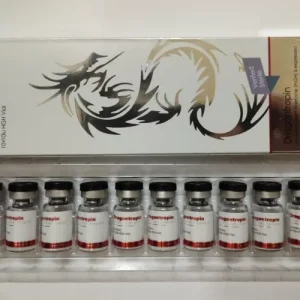Steroids
What is EPO and Blood Doping in Cycling and Endurance Sports?

Sporting activities such as cycling and endurance sports require energy for better performance. The amount of red blood cells and the oxygen determines athletic performance. On this note, many athletes, sportsmen, and women are taking hard drugs to boost oxygen and red blood cell production in their body. But the problem is that most of the substances available for athletes have strenuous health risks, which made them not suitable for anyone. The truth is that most of the hard drugs used by athletes to cheat in the game are banned. In this article, you will learn about EPO and blood doping in cycling and endurance sports. So, take time to read to the end of this article to get comprehensive information about the effect of Blood Doping and EPO in Cycling and Endurance sports.
MUST READ: What Impact Have Anabolic Steroids Taken On Your Heart and Blood Cells?
Before we can proceed to explain more about the effects of blood doping in endurance sports and cycling, it is necessary to educate you more about the meaning of doping and EPO. Blood doping is not a new topic in the athletic and sports world. It is an unlawful or prohibited method of enhancing athletic performance through the use of synthetic blood-boosting methods. It is a synthetic or artificial way of boosting the ability of the body to allow the channel more oxygen to the muscles. The reason is to enhance the endurance and performance of the athletes in the long-running distance, cycling, and more.
The effects of blood doping
The effects of blood doping are mostly required when there is shortage of hemoglobin in the bloodstream. The hemoglobin that gives the blood its color the people know. It is responsible for oxygenating the blood of the vertebrates. The red proteins come in four different unique with each unite containing an iron atom that is held together by a group known as haem. Also, the hemoglobin is a unique protein responsible for carrying oxygen to the bloodstream of the vertebrates.
Therefore, an increase in hemoglobin through blood doping can increase the amount of oxygen required in the body to fuel athlete muscles for higher performance. With blood doping, there can be an increase in stamina and endurance for cycling and other sports requiring long-distance events. So, it is not only used by cycling but other endurance sports like running, weight lifting, and others. Many sports organizations, such as the Olympic Committee have banned blood doping, which made it illegal for the athletes to go for any blood doping drugs. But, will explain more about the EPO in this article.
Related Article: Best Places to Order Blood Tests Online in the USA
Types of Blood Doping You Need To Know
There are three major types of blood doping you need to know as an athlete. The types are:
- Erythropoietin (EPO) injections.
- Blood transfusions.
- Injections of the artificial oxygen carriers.
The EPO Injections For Blood Doping
Erythropoietin (EPO) is a natural hormone produced in the body of the kidney. The essence of this hormone is to regulate red blood cell production to enhance its capacity aerobically. Clinically, the EPO injection is done to trigger red blood cell production for the treatment of different health issues related to the blood. So, it is used to treat an anemic patient and patients with a related chronic illness like the last stage of the kidney disease.
The use of the EPO by the athletes is to stimulate the body and increase the production of red blood cells in a higher amount than normal. The goal is to boost performance for sporting activities. The increase in the production of red blood cells above normal can result in blood clotting and thickening. Resulting in chronic health issues like stroke and other related health issues. So, before you take the EPO injection into your body to increase the production of red blood cells and boost performance in sports. You should take time to consider the health risk associated with it. There are some long term risks associated with it, which made it necessary for people to be wary of injecting the drug into their bloodstream.
The Truth about Blood Doping Through Blood Transfusions
Blood transfusion is a practice in the medical field. It is used when there is a need to replace blood lost through surgery or injury. More so, transfusions are necessary when there is a need for replacement of blood to patients whose red blood count is low as a result of kidney failure, anemia, or other medical treatments or conditions.
Must Read:: Donating Blood While On Steroids
On the other hand, the illicit transfusions of blood are carried out to boost performance in sportsmen and women. The popular blood transfusions in the athletes are of two types, including autologous and homologous transfusion.
- The Autologous transfusion: The case of the autologous transfusion, the blood of the athlete is collected and stored for the used on the same athlete in the future. Most athletes that have competitions do prepare ahead of time to ensure best performance. So, their blood are drawn by their doctor and used at the time of their event to boost their performance and endurance.
- The Homologous transfusion: In the case homologous transfusion, the athlete gets the blood of another person with the same type to boost red blood count in the body.
The Artificial Oxygen Carriers for Blood Doping
Another popular method of blood doping used by the athlete is the synthetic or artificial carriers. It is a chemical with the capability of carrying oxygen. There are many types of it available in the medical world, but in this article, we will take a look at two of the examples. These are PFCs (per fluorocarbon) and HBOCs (hemoglobin-based oxygen carriers).
Buy Now >> ELDON BLOOD TYPING KIT
There is a medical application for synthetic or artificial oxygen carriers for emergency therapy. The use of this method is when certain conditions are appropriate. The conditions that determine the use of the oxygen carriers include:
- There is need for blood transfusion in patient without availability of human blood.
- The human blood transfusion is not an option due to blood infection.
- The patient’s condition is critical without enough time to carry out test and find matching blood type for the patient.
The above mentioned are the conditions necessary that warrant the use of the artificial oxygen carrier for emergency therapy. However, athletes are making use of synthetic oxygen carriers for a different reason. They are making use of this method to get the same result from other forms of blood doping for their athletic performance. The method is effective in increasing fueling the muscle with the oxygenated blood.
Significant Facts About Blood Doping
There is a unique test for blood doping. The test helps to detect drug use in the athlete. Since blood doping is an illegal way of triggering the body during a performance in sports. It is necessary to figure the risk factor associated with it if you want to get it done on you. So, figuring out the possible risks associated with blood doping and EPO is necessary before going for it. There are a plethora of tests indicating risks associated with blood doping.
Blood Doping Risks and Potential Dangers You Need To Know
When the red blood cell production is modified, the heart is mostly the organ that suffers most. Increasing the number of red blood cells produced will result in the thickening of the blood, putting the heart into added pressure to pump the thickened blood to other vital organs of the body. Due to the blood doping, there is always an increase in the following:
- Stroke.
- Heart attack.
- Blood clot.
Different types of blood doping come with different types of risks. Blood doping done through transfusion of tainted blood can result in various infectious diseases, including:
- Hepatitis B.
- HIV.
- Hepatitis C.
Adding to these health issues associated with EPO and blood doping, many others are not popular base on recent studies. Abuse of EPO triggers high blood pressure (hypertension) by producing a higher amount of red blood cells to crowd the plasma. The risk of the increasing production of blood is that it results in blood thickening, which induces constriction of muscle and leads to the closing of the blood, stroke, and heart attack.
More so, there may be an interaction between hypotension drugs and EPO. Some of the drugs with negative interactions with the EPO are fludrocortisone (Astonin) and midodrine. That is why the professional sportsmen and men are not to take the drugs except administered by their doctor. The truth is that the use of EPO with drugs used to cancer such as breast cancer, Cytoxan (cyclophosphamide), leukemia, and lymphomas.
EPO
EPO is among the banned anabolic substance in the sporting world. The sporting agencies do carry out a regular test on the athletes to find out if they are using the banned drug or not. There is strict scrutiny of the athletes, and anyone found guilty of abusing the drug will be penalized through suspension or total stripping of the title. More so, some athletes have lost their titles for taking EPO or other hard PED drugs.
Related Article:: How Can Steroids Affect Athletes – Benefits and Side Effects of Steroids
The EPO And Blood Doping Popularity Among Athletes In The World
Sports fans are conversant with the news about sportsmen and women caught using hard substances, such as Performance-enhancing drugs (PEDs) and more. The PEDs is a popular anabolic substance used by the athletes to boost performance. But the drug under the same umbrella, which most people do not know is the EPO.
This drug has recorded widespread controversies and abuse among the athletes, such as professional cyclists and more since the earlier 80s. Your knowledge of this drug, its effect, risk, and controversies will make it easy for you to know the best way to avoid being a victim. Many professional cyclists have put their life to danger through the abuse of this drug.
The Controversies Surrounding EPO Use among the Athletes in the World
The use of EPO, banned in the international sports community, such as Olympic and others since the 1990s and in 2000 blood sample used to test for drug use in the athlete during the Summer Olympic. In the year 2006, Floyd Landis was the first to lose his title for drug abuse through doping. Armstrong is another athlete to lose his title for EPO abuse and blood doping. Many other professional cyclists have tested positive for the use of EPO, and some of them include Philippe Gaumont, David Millar, Jesus Manzano, and Willy Voit. With the controversies surrounding the use of EPO and blood doping, one may wonder about the possible effect of this drug on athletic performance. If that is your question, you should not ask further as the answer to your question is not farfetched.
The Benefits Associated With EPO and Blood Doping Drugs
Despite the enormous health risks associated with EPO and other PED for blood doping, there are still some benefits associated with it, which attract more athletes to them. Some of the benefits associate with this drug are explained here.
Improve Your Strength and Live Stronger
Erythropoietin or EPO in the acronym is a natural peptide hormone that is produced by the kidney. The hormone is responsible for triggering the bone marrow to produce more red blood cells. Clinically, the peptide hormone is useful in treating blood deficiencies in the body.
It is recommended during emergency and anemia treatment. However, the misuse of abuse of EPO is banned. Although erythropoietin is banned, its popularity in the cyclist and endurance event has rapidly increased. So, one of the main reasons people go for this drug despite being banned is that helps them to live stronger and perform better in sporting competition.
Performance beyond the Limit of Human Being in Sports with EPO
Performing beyond the human limit is possible with the help of the EPO and other blood doping methods. It is the drug that gives users full strength after being injected into the bloodstream. But it is only for those that can afford the cost of it. Accessing the EPO is easy when you check through the US site. You will find an injectable full strength solution for a hundred and fifty pounds. But to get the dose that will enough to boost your performance beyond the human limit, you must be ready to spend some thousands of pounds. You need not less than three thousand five hundred pounds to get the EPO injection that can last for the training cycle in circling or other endurance sports events. Therefore it is not affordable to the amateur cyclists and endurance training.
Some Common Questions About EPO And Blood Doping Cycling
With the prevalence of EPO and blood doping, it is easy for someone to wonder about its effects on the body. Also, armature cyclists usually wonder if they can improve their strength and performance by injecting drugs into their bloodstream. If you have wondered about that also, you are in the right place as you will get answers to your questions here. Some of the questions about this product and the answers include:
Can I Get Stronger And Perform Better With The Use Of EPO?
That is one of the most popular questions you can find among the cyclists and other athletes. The answer is simple, injecting this drug into the bloodstream triggers the production of red blood cells unnaturally. With the increased red blood cell comes the possibility of boosting the muscle strength, endurance, and agility for performance in sports.
How EPO Works to Increase Endurance?
The main effect of EPO is to increase strength and endurance. That is why it is used by runners, cyclists, and other endurance trainers. Long-distance runners go for this injectable drug to make them perform beyond normal human strength. To ensure the effectiveness of the EPO, it is injected under the skin to induce the production of red blood cells and the delivery of more oxygen to the muscle.
Is erythropoietin drug still useful for cycling?
While some people have ended up damaging their kidney and increasing their risk of stroke, heart disease, and others with the EPO abuse, a new study has it that the drug may not improve performance in cycling. The discovery about this drug has resulted in controversies and discouraged more runners, cyclists, and more from taking this as it does not produce the same result needed to perform better as cyclists of a long-distance runner.
Is EPO good enough for sports and endurance?
Before you starting taking EPO for no medical purpose, it is necessary to research more about the drug. Make sure that you find out the effects of this drug on the body and how it works to boost performance and endurance. There is only a 6% increase in performance on the distance runners after taking the hormone for four weeks. With this knowledge, it is obvious that the drug does not produce the same result as purported by the public, which resulted in its abuse among the athletes.
Is EPO Categorized Among the Steroid?
Although anabolic steroids are the popularly known PEDs used by the athletes, the EPO is also in the same category. The drug is clinically approved and recognized to help in handling different health issues. Also, the use of this drug for medical purposes is mainly during an emergency when all hopes are lost. Also, when blood transfusion is not an option due to certain reasons. The EPO is always the solution to the immediate problem. The health risks associated with the use of this substance comes following its abuse.
Must Read:: How Do American Swimmers Manage to Trash Cheating Scumbags Without Steroids?
Some of the Short Time Side Effects of EPO You Need To Know
If you are planning to boost your performance in long-distance running with EPO. It confirms the short term and long term side effects associated with it. There exist some temporary side effects associated with the abuse of EPO, which you need to know before going for it. Some of these side effects you need to know include:
- Nausea.
- Fever.
- Swelling.
- High blood pressure.
- Dizziness.
When you develop any of the side effects mentioned here, you should discontinue the use of the drug as quickly as possible. Make sure that you consult your doctor when you discover that you discover a strange feeling in your body following the use of the drug.
How to Administer EPO for Best Result?
Depending on the effects you want to from the EPO, there are many ways to administer the drug. Medically, you can use the drug in three different ways, and that includes:
- Epoetin Alfa.
- Darbepoietin Alfa.
- Injection intravenous to the vein.
So, if you do not like the pain of the injection needle. Also, you can take the medication in another way to get the same result.
Conclusion
Notwithstanding the temptation to boost your endurance, performance, or others through the use of EPO, you must consider the health risk associated with it. Abuse of drugs generally is dangerous to health. So, even if you are armature athletes and discovered with low performance, you should not start your career with supplements. There are many other healthy solutions for underperforming athletes, which they can utilize to improve their overall strength, endurance, and performance.
Overall
There are ways to resolve your underperforming challenge as an athlete. One way to do that is by talking to your coach to figure out the safer solution to your problem. Alternate training options and nutrition could be the solution you need to regain y our level as a trainer. Your coach will find out the best solution to your career as a cyclist and not drugs. Some other treatment options can yield the same result without causing more damages to your health. With such a solution, you will stay away from drug abuse to damage your life forever. So, go on and improve your endurance as a cyclist or runner through a safer method.
Steroids
AOD-9604: The Fat-Burning Peptide Explained
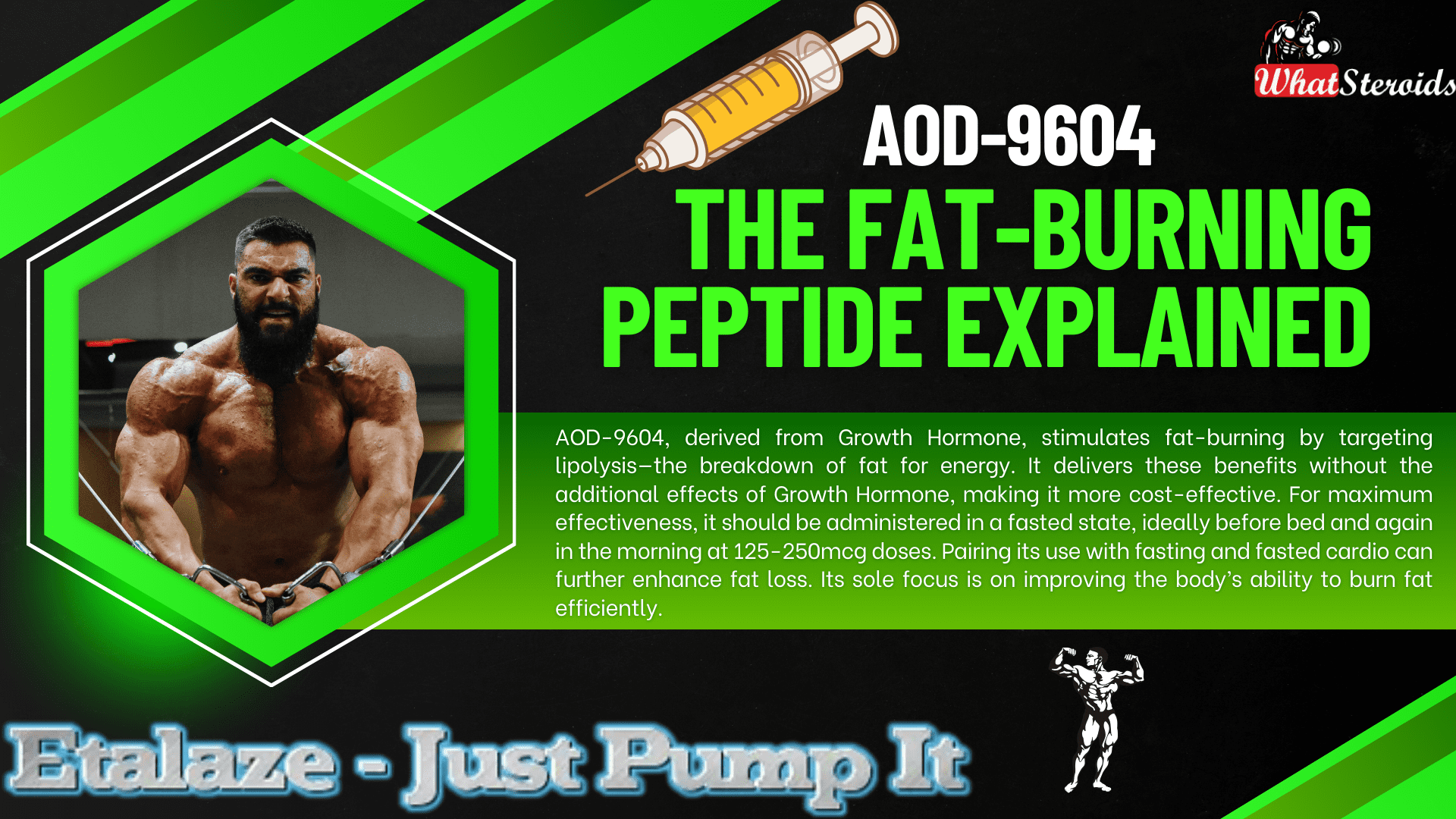
AOD-9604, along with the similar HGH Frag 176-191, is a peptide derived from Growth Hormone that includes only the amino acids in HGH responsible for stimulating fat breakdown, known as lipolysis.
This means that these peptides offer the fat-burning benefits of HGH without its other effects—whether beneficial or adverse—and come at a lower cost.
Related Article: Anavar Cycle for Men and Women
Lipolysis refers to the process where fat cells are broken down to be utilized as energy. AOD-9604 promotes accelerated fat loss by increasing the body's use of fat as fuel.
For optimal results, the peptides should be used in a fasted state. AOD-9604 and Frag 176-191 are most effective when administered at a dose of 125-250mcg before bedtime (at least 3-4 hours after eating) and in the morning at the same dose, followed by a fasting period of 3-4 hours, ideally combined with fasted cardio.
Check Out Dragontropin HGH 100 IU by Dragon Pharma
Similar Peptides with Fat-Burning Effect
Here’s a list of 10 peptides similar to AOD-9604, each with a brief description:
Ipamorelin: A growth hormone-releasing peptide (GHRP) that stimulates the natural release of growth hormone, promoting fat loss, muscle growth, and improved recovery without affecting other hormones like cortisol or prolactin.
CJC-1295: A peptide that increases growth hormone and IGF-1 levels, aiding in fat loss, muscle gain, and improved sleep quality. It has a long half-life, making it convenient for users.
HGH Frag 176-191: A fragment of human growth hormone specifically designed for fat-burning. It targets adipose tissue without the broader effects of full-length HGH.
Tesamorelin: Known for reducing visceral fat, this peptide stimulates the release of growth hormone and is often used for weight management and metabolic health.
BPC-157: While primarily known for healing and recovery, BPC-157 can support fat loss indirectly by improving gut health and reducing inflammation.
Melanotan II: Originally developed for skin tanning, it also has appetite-suppressing properties, making it useful for weight management.
Thymosin Beta-4 (TB-500): Focused on healing and recovery, it can enhance physical performance and indirectly support fat loss through improved activity levels.
GHRP-6: A growth hormone-releasing peptide that boosts appetite and metabolism, aiding in muscle growth and fat loss.
Semaglutide: A GLP-1 receptor agonist that regulates appetite and blood sugar levels, making it effective for weight loss and metabolic health.
MK-677 (Ibutamoren): A growth hormone secretagogue that increases growth hormone and IGF-1 levels, promoting fat loss, muscle gain, and improved recovery.
List of Peptides With a Counteractive Effect Bodybuilders Must Avoid
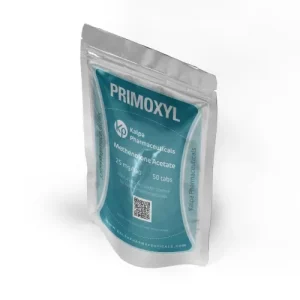 Click Here to Buy Primoxyl 25 by Kalpa Pharmaceuticals
Click Here to Buy Primoxyl 25 by Kalpa Pharmaceuticals
Some peptides can inadvertently lead to fat gain due to their effects on metabolism and appetite regulation. Here are a few that bodybuilders might want to avoid or use cautiously:
- GHRP-6 – While it stimulates growth hormone release, it also significantly increases appetite, which can lead to excess calorie consumption and fat gain.
- IGF-1 LR3 – This peptide enhances muscle growth but can also promote fat storage if not carefully managed with diet and training.
- MK-677 (Ibutamoren) – Though technically a growth hormone secretagogue rather than a peptide, it boosts GH levels but often leads to increased hunger and potential fat accumulation.
- CJC-1295 with DAC – While effective for muscle growth, its prolonged GH release can sometimes lead to unwanted fat retention if not paired with a strict diet
Overall
AOD-9604, derived from Growth Hormone, stimulates fat-burning by targeting lipolysis—the breakdown of fat for energy. It delivers these benefits without the additional effects of Growth Hormone, making it more cost-effective. For maximum effectiveness, it should be administered in a fasted state, ideally before bed and again in the morning at 125-250mcg doses. Pairing its use with fasting and fasted cardio can further enhance fat loss. Its sole focus is on improving the body’s ability to burn fat efficiently.
Read More: How Much Do You Know About B-AET? A Fat Burner You’ve Been Missing
Bodybuilding
Understanding Trenbolone-Induced Cough (“Tren Cough”)

Trenbolone, a potent anabolic steroid, can sometimes cause “tren cough”—a sudden and intense coughing episode shortly after injection. Although not exclusive to Trenbolone, it is more commonly associated with this substance due to its highly irritant nature.
 Click Here To Buy 1-Test Cyp 100 by Nakon Medical
Click Here To Buy 1-Test Cyp 100 by Nakon Medical
Mechanisms Behind Tren Cough
Solvent and Carrier Irritation
Trenbolone formulations often include volatile solvents like benzyl alcohol or benzyl benzoate, which may irritate lung tissues when absorbed quickly into systemic circulation.
Prostaglandin Release
Trenbolone promotes increased production of prostaglandins, particularly PGF2α. This compound triggers contraction in the smooth muscles of the lungs, leading to bronchoconstriction and coughing.
Micro-Oil Embolism
Tiny oil droplets from an injection can reach capillaries and travel to the lungs, causing mild embolic reactions that lead to temporary oxygen deprivation and coughing.
Histamine and Mast Cell Activation
For some individuals, Trenbolone triggers histamine release and mast cell activation, mimicking an allergic response and causing bronchospasms and cough reflexes.
Related Article: Best Syringes for Steroid Injection on Amazon
Using Salbutamol (Albuterol) to Manage Tren Cough
- Salbutamol, a widely-used β2-adrenergic receptor agonist, can alleviate tren cough symptoms by:
- Relaxing bronchial muscles, easing spasms that cause coughing.
- Inhibiting prostaglandin effects, reducing bronchoconstriction associated with PGF2α.
- Opening airways, preventing severe respiratory restrictions in susceptible individuals.
Application Methods
Inhaler (Optimal)
Take 1–2 puffs of salbutamol (100–200 mcg) 5–10 minutes before a Trenbolone injection. If coughing occurs afterward, additional puffs can swiftly resolve the issue.
Oral Tablets (Moderate)
Consuming 2–4 mg tablets 30–60 minutes before injection offers slower, longer-lasting relief but may be less effective than inhalation methods.
Nebulizer (Severe Cases)
For individuals with frequent episodes, nebulized doses of 2.5 mg salbutamol can provide substantial relief.
Preventive Measures to Reduce Tren Cough Risk
- Inject slowly to minimize systemic absorption and irritant effects.
- Split doses to lower reaction severity with smaller quantities.
- Opt for ventrogluteal injection sites, which have fewer blood vessels, reducing oil embolism risk.
- Choose lower-concentration solutions to lessen irritation, as higher concentrations (e.g., Tren Ace 200 mg/ml) are more likely to provoke reactions.
What Other Steroids Can Induce Coughing?
Here's a curated list of peptides, SARMs, and PEDs that may potentially cause coughing or respiratory irritation in bodybuilders and fitness enthusiasts:
Peptides
IGF-1 LR3 (Insulin-like Growth Factor): Known for its anabolic effects, IGF-1 LR3 can occasionally cause mild respiratory irritation due to systemic absorption.
TB-500 (Thymosin Beta-4): While rare, improper injection techniques or high doses may lead to transient coughing episodes.
GHRP-6 (Growth Hormone-Releasing Peptide): This peptide can stimulate histamine release, potentially leading to bronchospasms and coughing.
SARMs (Selective Androgen Receptor Modulators)
RAD-140: (Testolone) Some users report throat irritation or coughing, often attributed to solvents used in liquid formulations.
YK-11: Known for its myostatin-inhibiting properties, YK-11 may cause mild respiratory discomfort in sensitive individuals.
LGD-4033 (Ligandrol): Though uncommon, some users experience coughing due to carrier solvents or allergic-like reactions.
PEDs (Performance-Enhancing Drugs)
Boldenone Undecylenate (Equipoise): This injectable steroid can cause “Equipoise cough,” similar to tren cough, due to oil embolism or irritant solvents.
Testosterone Suspension: The water-based formulation may lead to coughing episodes if injected improperly or absorbed rapidly.
Nandrolone Decanoate (Deca-Durabolin): While less common, coughing can occur due to histamine release or systemic irritation.
More Tips to Minimize Coughing Risks
- Use proper injection techniques to avoid embolic reactions.
- Opt for lower-concentration solutions to reduce irritant effects.
- Consider antihistamines or bronchodilators for individuals prone to respiratory sensitivity.
Read More: Joint Stiffness: How to Manage It While on AAS
Are There Alternatives to Cough-inducing Steroids?
Here are some alternatives to cough-inducing steroids that can provide similar anabolic effects while minimizing respiratory irritation:
Peptides
IGF-1 LR3 (Insulin-like Growth Factor)
Promotes muscle growth and recovery without the irritant properties of certain steroids.
TB-500 (Thymosin Beta-4)
Enhances tissue repair and reduces inflammation, making it a safer option for recovery.
BPC-157 (Body Protection Compound)
Known for its healing properties, it supports muscle repair and joint health.
SARMs (Selective Androgen Receptor Modulators)
RAD-140 (Testolone)
Provides significant muscle-building effects with fewer systemic side effects compared to traditional steroids.
LGD-4033 (Ligandrol)
Boosts lean muscle mass and strength without the risk of respiratory irritation.
MK-677 (Ibutamoren)
Stimulates growth hormone release, aiding in muscle growth and recovery.
Natural Alternatives
Turkesterone
A plant-based ecdysteroid that supports muscle protein synthesis and recovery.
Ecdysterone
Another natural compound that mimics anabolic effects without the harsh side effects.
Creatine Monohydrate
Enhances strength and muscle mass through improved energy production during workouts.
Other Options
Human Growth Hormone (HGH)
Promotes muscle growth and fat loss, though it requires careful monitoring due to potential side effects.
Testosterone Boosters
Natural supplements like D-Aspartic Acid or Tribulus Terrestris can help optimize testosterone levels for muscle growth.
SARMs Alternatives
Legal and safer versions of SARMs are available, offering similar benefits without the risks associated with traditional SARMs.
Overall
We have explored the phenomenon of "tren cough," a sudden, intense coughing episode often caused by Trenbolone injections due to factors like solvent irritation, prostaglandin release, micro-oil embolism, or histamine activation. Preventive measures such as using salbutamol (via inhaler, oral tablets, or nebulizer), injecting slowly, splitting doses, and opting for lower-concentration solutions were highlighted.
Additionally, alternative compounds to tren cough-inducing steroids were discussed, including peptides like IGF-1 LR3 and TB-500, SARMs such as RAD-140 and LGD-4033, and natural options like Turkesterone, ecdysterone, and creatine. These alternatives provide anabolic effects while minimizing respiratory side effects. The conversation also underscored the importance of proper injection techniques and thoughtful compound selection to reduce risks.
Steroids
Creatine vs Myostatin: An Expert’s Analysis
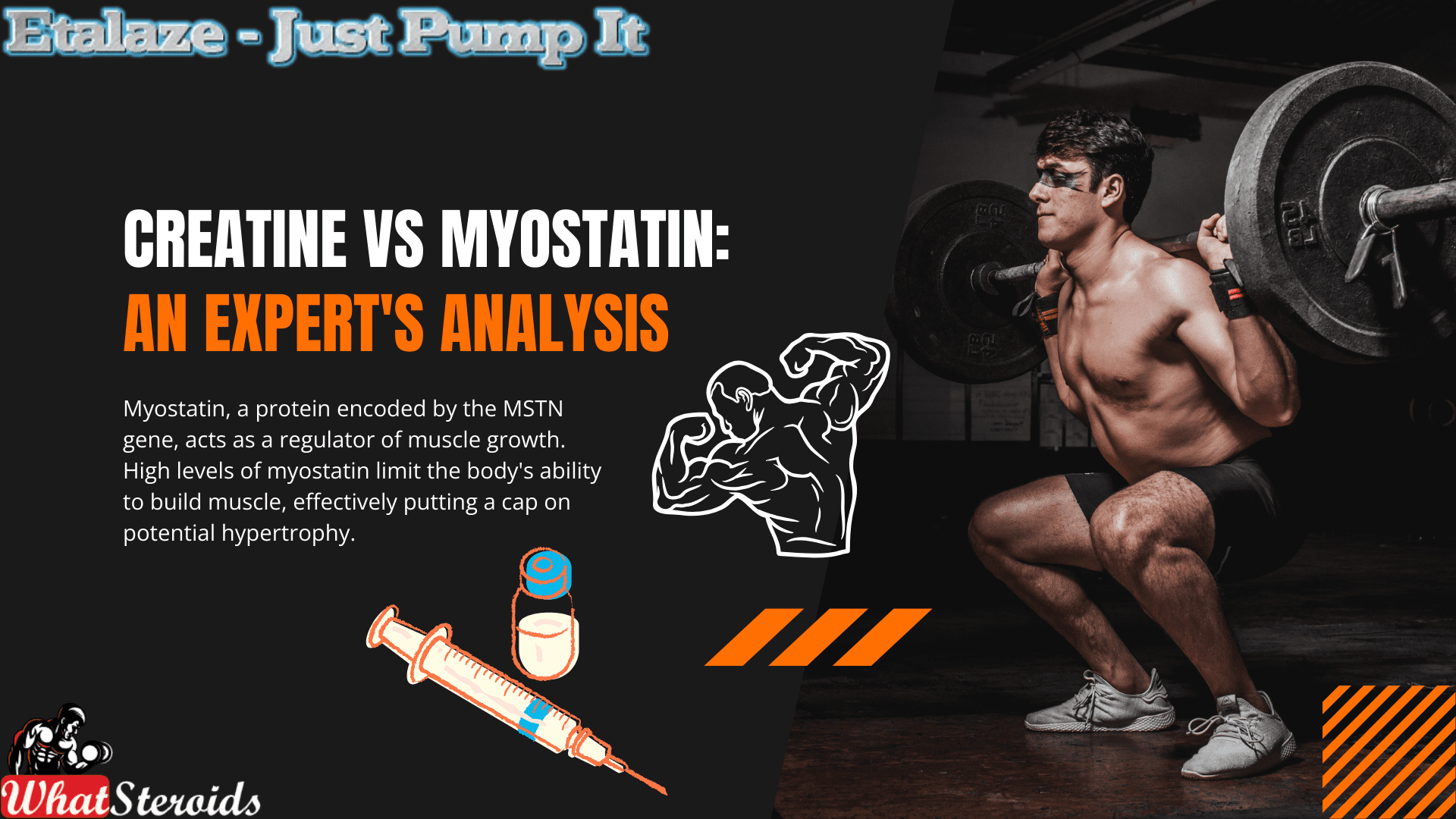
Myostatin, a protein encoded by the MSTN gene, acts as a regulator of muscle growth. High levels of myostatin limit the body's ability to build muscle, effectively putting a cap on potential hypertrophy. Inhibiting myostatin has become a focal point for bodybuilders looking to break through plateaus and achieve significant muscle gains. The question is: can creatine, a popular and widely available supplement, help in this regard?
Medical History of Myostatin and Creatine
Myostatin and creatine, while popular now in the bodybuilding world, have their roots in entirely different contexts:
Myostatin: Natural Muscle Growth Regulator
Myostatin is a protein originally identified for its role in regulating skeletal muscle mass. In nature, it serves an evolutionary purpose: by limiting muscle growth, it conserves energy, ensuring that animals (and humans) don’t expend unnecessary resources maintaining excessive muscle tissue. This was especially important in the wild, where energy efficiency could mean the difference between survival and extinction.
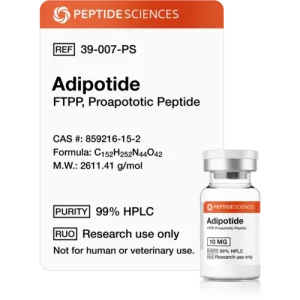 Check Adipotide (FTPP) 10mg by Peptide Science
Check Adipotide (FTPP) 10mg by Peptide Science
In the medical field, research into myostatin has focused on its role in muscle-wasting diseases. Scientists are exploring ways to inhibit myostatin to treat conditions like muscular dystrophy, where excessive muscle loss impairs quality of life. This therapeutic potential is where the idea of myostatin inhibition first began—long before bodybuilders latched onto the concept.
Creatine: Energy and Medical Applications
Creatine was originally studied for its role in energy metabolism. It’s a naturally occurring compound stored in muscle cells and plays a critical part in replenishing ATP (adenosine triphosphate), the body’s primary energy currency during short, high-intensity activities.
Before becoming a bodybuilding staple, creatine gained recognition in medical and sports science for its ability to improve athletic performance and assist with recovery. Furthermore, in medicine, creatine was investigated for neurological conditions such as Parkinson’s disease, Huntington’s disease, and muscular dystrophy, given its potential to improve muscle function and brain energy metabolism.
In the sports world, it was initially adopted by sprinters and weightlifters in the 1970s and 1980s for its energy-enhancing benefits.
Both myostatin and creatine have found new life in bodybuilding circles, demonstrating how discoveries in natural physiology and medical science can lead to transformative applications in fitness.
Benefits of Creatine as a Myostatin Inhibitor
Muscle Growth Potential: Research suggests that creatine, when paired with intense resistance training, may inhibit myostatin to a degree, fostering an environment for enhanced muscle growth.
Improved Exercise Performance: Creatine is well-known for its ability to increase ATP production, translating to better performance during high-intensity activities.
Versatility Across Fitness Levels
Whether you're a beginner or an advanced athlete, creatine offers benefits that complement various stages of muscle-building.
Must Read: A New Caffeine? What You Need to Know about Teacrine
Affordability and Accessibility
Compared to specialized myostatin inhibitors like YK-11 and ACE-031, creatine is significantly more affordable and accessible.
Side Effects of Creatine
While generally safe for most individuals, creatine supplementation does come with some potential side effects:
Water Retention: Some users experience bloating due to increased water retention in muscle cells.
Gastrointestinal Issues: High doses may lead to stomach upset or diarrhea.
Kidney Concerns: Although rare, prolonged excessive use could strain the kidneys, particularly in individuals with pre-existing conditions.
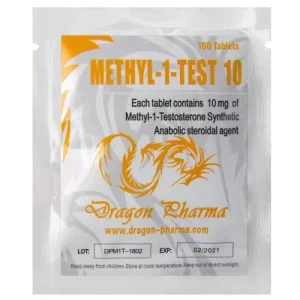 Buy Methyl-1-Test 10 -100 tabs by Dragon Pharma
Buy Methyl-1-Test 10 -100 tabs by Dragon Pharma
Alternatives to Creatine for Myostatin Inhibition
YK-11: A synthetic myostatin inhibitor derived from SARMs, offering more potent results but accompanied by more significant risks.
ACE-031: A peptide that directly inhibits myostatin, though it remains in experimental phases and is not legally approved in many regions.
Natural Alternatives
Follistatin-rich Foods: Eggs and dairy products may have natural myostatin-inhibiting properties.
Resistance Training: Intense and consistent weightlifting alone can naturally lower myostatin levels.
Where to Buy Creatine
Creatine is readily available worldwide. It can be purchased from:
Local Pharmacies and Nutrition Stores: Ideal for trusted and immediate access.
Online Platforms: Websites like Amazon, iHerb, or bodybuilding-specific stores offer a variety of brands and formulations.
Supplement Brands: Well-established brands such as Optimum Nutrition, MyProtein, and Cellucor often carry high-quality creatine.
Legality of Myostatin Inhibitors
Creatine: Creatine is completely legal and widely accepted as a dietary supplement.
YK-11 and ACE-031: These compounds exist in a legal gray area in many countries due to their experimental nature and potential risks. It's essential to research local laws before considering these options.
Best Stores and Suppliers
For reputable products, consider:
Transparent Labs: Known for purity and transparent labeling.
Optimum Nutrition: Offers pharmaceutical-grade creatine monohydrate.
Bulk Supplements: A great choice for bulk buyers seeking affordability and quality.
Our Advice to Bodybuilders
Always consult with a healthcare professional before starting any new supplement, especially if you are already using AAS or other advanced compounds.
Prioritize a balanced diet and consistent exercise routine. Supplements like creatine work best as part of a holistic approach to fitness.
Stay hydrated while using creatine to minimize water retention side effects and support kidney health.
Related Article: Best Syringes for Steroid Injection on Amazon
Overall
While creatine may not be as potent a myostatin inhibitor as advanced compounds like YK-11 or ACE-031, its affordability, safety, and accessibility make it a valuable addition to any bodybuilder's supplement stack. By leveraging its benefits alongside proper training and nutrition, you can maximize muscle growth and overcome plateaus, regardless of your fitness level.
-

 Steroids2 years ago
Steroids2 years agoShavers and Other Body Grooming Equipment for Bodybuilders In 2023
-

 Steroids2 years ago
Steroids2 years agoChatGPT and Other Avenues to Find Great Bodybuilding Coaches
-

 Steroids2 years ago
Steroids2 years agoBest Oil Recommendations Before Competition for Subtle Shimmer
-

 Steroids2 years ago
Steroids2 years agoPowerlifting Vs Power Building: Find Out the Big Difference and When to Shift Between the Two
-

 Nutrition1 year ago
Nutrition1 year agoEverything Nutritional Food: What’s Too Much Or Too Little
-

 Bodybuilding Products1 year ago
Bodybuilding Products1 year agoTelmisartan In Bodybuilding: An Expert’s Advice
-

 Anabolic Steroids1 year ago
Anabolic Steroids1 year agoLegality of Anabolic Steroids In Latin America
-

 Beginners2 years ago
Beginners2 years agoTren Cycle for Beginners
-

 Bodybuilding1 year ago
Bodybuilding1 year agoChia Seeds in A Bodybuilder’s Diet: An Expert’s Advice
-

 Bodybuilding1 year ago
Bodybuilding1 year agoList of FDA-Approved Peptides
-

 Anabolic Steroids9 months ago
Anabolic Steroids9 months agoJoint Stiffness: How to Manage It While on AAS
-

 Bodybuilding8 months ago
Bodybuilding8 months agoPrimal Movements: Our Ultimate Guide for Maximum Results
-

 Steroids12 months ago
Steroids12 months agoAnadrol Cycle: Benefits, Doses, Alternatives, etc.
-

 Bodybuilding2 years ago
Bodybuilding2 years agoCompetition Prep Cycle for Pro Bodybuilders
-

 Bodybuilding8 months ago
Bodybuilding8 months agoHow Effective is Bone Broth for Recovery?
-

 Steroids10 months ago
Steroids10 months agoOmnitope (Oxytocin)
-

 Bodybuilding1 year ago
Bodybuilding1 year agoHow Much Is Too Much Cardio? Understanding Heart Rate Zones
-

 Steroids9 months ago
Steroids9 months agoSleeping Positions for Effective Muscle Recovery
-

 Anabolic Steroids11 months ago
Anabolic Steroids11 months agoHow Much Do You Know About B-AET? A Fat Burner You’ve Been Missing
-

 Bodybuilding1 year ago
Bodybuilding1 year agoCalorie Dumping: A Bodybuilder’s Guide
-

 Bodybuilding8 months ago
Bodybuilding8 months ago2nd Edition of Natural Bodybuilding Competition Facts
-

 Product Reviews11 months ago
Product Reviews11 months agoTop Vitamins for Skin Health
-

 Bodybuilding1 year ago
Bodybuilding1 year agoDemystifying Hypertrophy Training
-

 Bodybuilding8 months ago
Bodybuilding8 months agoAre Nootropics a Better Option to AAS?
-

 Steroids11 months ago
Steroids11 months agoMajor Bodybuilding Peptides Explained


